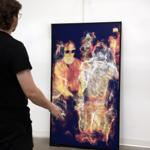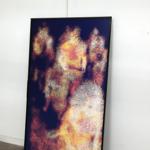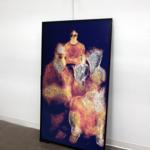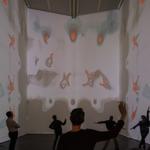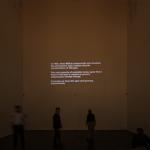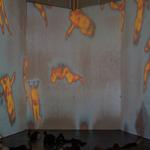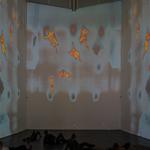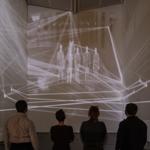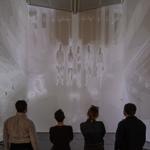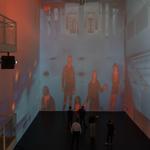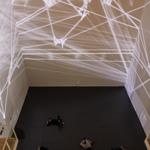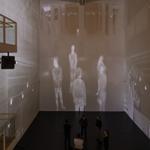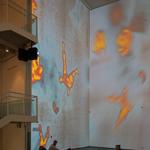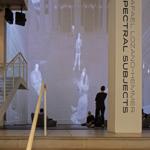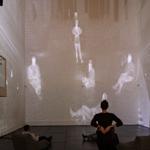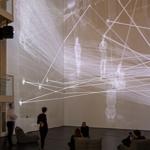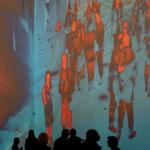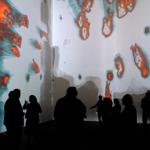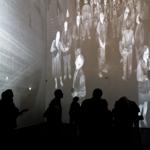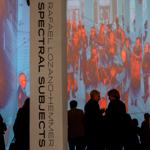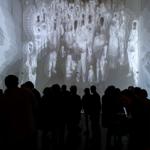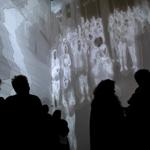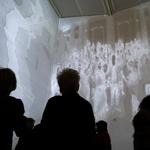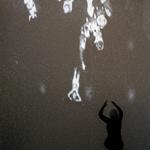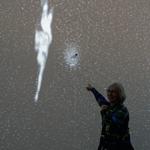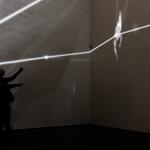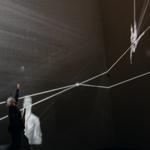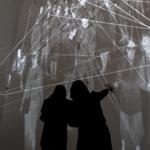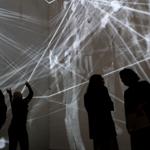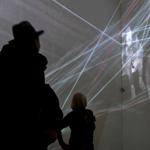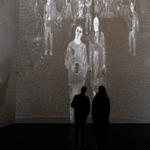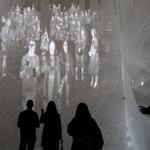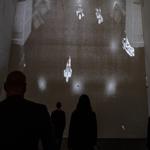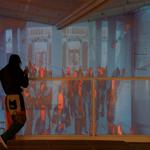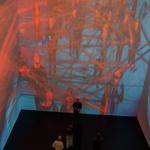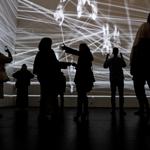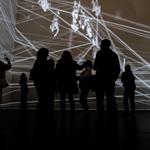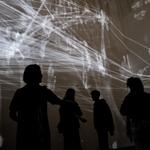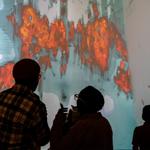Spectral Subjects
“Spectral Subjects” is a thermal observatory that displays a constantly updating map of the room's temperature. Using thermographic cameras, the project detects heat and cold in the environment, including the building’s air circulation and ventilation, visitors’ body heat, and inanimate objects. As temperature is detected, the artwork creates a visible manifestation of the public’s “heat signature” in various ways, mixing live feeds with recently past heat signatures, materializing thermal echoes of the atmosphere, and creating an evolving portrait of uncanny spectral traces that make the atmosphere tangible. The artwork has two versions: a unique projection-based treatment that can be adapted to any architecture, and an edition that can be adapted to flatscreens of different sizes.
As with previous biometric art projects by Lozano-Hemmer, the piece is a call to think of the human body as a continuum with the environment around us. The skin is not the limit of our body but only its visible limit: sound, smell, heat, air/breath, biological waste and even chemical signals in the form of pheromones, are constantly seeping in and out across our body's visible limits, our skin, which is incorrectly described as the boundary between the public and the private. Written and oral language, actions, movement, exteroception, are examples of other manifestations of our extension into our surroundings, as are the resulting buildings, songs, environmental decimation, artworks, and the Anthropocene in general.
Thermal cameras are typical of sites of surveillance such as shopping malls, hunting grounds, national borders, schools, airports, prisons, and now increasingly, domestic and corporate use. Most of the time the use of these cameras is covert, with the goal of extracting information, such as identification, and reserved for the small screens of closed-circuit control rooms, or for automated analysis. Here, the image is amplified to an architectural scale, creating an immersive and “inversive” space where temporarily we are on the witnessing end of image-making. Crucially, in “Spectral Subjects” the images are not recorded and they are obfuscated, they don’t show us the subjects of the cameras as much as the relation between them and the environment. This allows for a degree of anonymity while maintaining performativity. “Spectral Subjects” emphasizes the active role of the spectator as an integral part of the artwork without whom the piece does not exist. The work is meant to perform a double duty: be a critical materialization of the reach of our society’s technological perception, and provide a playful expression of inclusion and presence, albeit inside a society of the spectacle, selfies, and reality TV.
For more than 30 years Rafael Lozano-Hemmer’s artworks have been tracking the public using a variety of technologies to create interactive artworks that are, in his words, “incomplete and out of control.” His pieces use biometric technologies such as pulse sensors, fingerprint scanners, microphones, respirators, face detection, skeletal tracking and others. In all cases, the artworks are not meant to create a sinister “portrait” of individuals but to create anonymous “landscapes” of participation, where the goal is to make evident relationships between people at a time of increased alienation from community. Paraphrasing the great American composer Frederic Rzewski, for Lozano-Hemmer the most important objective of art is to provide shared experiences for people to “come together.”
As with previous biometric art projects by Lozano-Hemmer, the piece is a call to think of the human body as a continuum with the environment around us. The skin is not the limit of our body but only its visible limit: sound, smell, heat, air/breath, biological waste and even chemical signals in the form of pheromones, are constantly seeping in and out across our body's visible limits, our skin, which is incorrectly described as the boundary between the public and the private. Written and oral language, actions, movement, exteroception, are examples of other manifestations of our extension into our surroundings, as are the resulting buildings, songs, environmental decimation, artworks, and the Anthropocene in general.
Thermal cameras are typical of sites of surveillance such as shopping malls, hunting grounds, national borders, schools, airports, prisons, and now increasingly, domestic and corporate use. Most of the time the use of these cameras is covert, with the goal of extracting information, such as identification, and reserved for the small screens of closed-circuit control rooms, or for automated analysis. Here, the image is amplified to an architectural scale, creating an immersive and “inversive” space where temporarily we are on the witnessing end of image-making. Crucially, in “Spectral Subjects” the images are not recorded and they are obfuscated, they don’t show us the subjects of the cameras as much as the relation between them and the environment. This allows for a degree of anonymity while maintaining performativity. “Spectral Subjects” emphasizes the active role of the spectator as an integral part of the artwork without whom the piece does not exist. The work is meant to perform a double duty: be a critical materialization of the reach of our society’s technological perception, and provide a playful expression of inclusion and presence, albeit inside a society of the spectacle, selfies, and reality TV.
For more than 30 years Rafael Lozano-Hemmer’s artworks have been tracking the public using a variety of technologies to create interactive artworks that are, in his words, “incomplete and out of control.” His pieces use biometric technologies such as pulse sensors, fingerprint scanners, microphones, respirators, face detection, skeletal tracking and others. In all cases, the artworks are not meant to create a sinister “portrait” of individuals but to create anonymous “landscapes” of participation, where the goal is to make evident relationships between people at a time of increased alienation from community. Paraphrasing the great American composer Frederic Rzewski, for Lozano-Hemmer the most important objective of art is to provide shared experiences for people to “come together.”
General info
Spanish name:
Presencia Espectral
Year of creation:
2024
Standalone
Technique:
Thermal camera, flatscreen and computer with custom software
Dimensions:
Variable
Keywords:
Edition:
6 Editions, 1 AP
Treatment
Technique:
Four projectors, Xenics Dione thermographic cameras
Dimensions:
Variable
Keywords:
Exhibitions
- Jardín Inconcluso, Museo de Arte Moderno, Mexico City, México, 2026.
- ZONAMACO, Galería Max Estrella, ZONAMACO Art Fair, Mexico City, México, 2026.
- Unfinished Garden Cocktail , Museo de Arte Moderno, Mexico City, México, 2025.
- Untitled Art Houston , bitforms gallery, George R. Brown Convention Center, Houston, Texas, United States, 2025.
- Rafael Lozano-Hemmer: Spectral Subjects, Museum of Contemporary Art Jacksonville, Jacksonville, Florida, United States, 2024 - 2025.
Credits
- Programming: Hugo Daoust
- Visualization: Luis Morales and Tim Belliveau
- Thermal Cameras: Xenics Dione thermographic cameras from Exosens. Special thanks to Chris Vogt, Jeremy Head, and Exosens team.
Bibliography
- Association for Advancing Automation. "Thermal Experience." Association for Advancing Automation (A3), 12 Feb. 2025. 2025. (english) (Websites)
- JAX Chamber. "Internationally Renowned Artist Rafael Lozano-Hemmer Creates New Work for MOCA Jacksonville." Jax Chamber, 20 Nov. 2024. Jacksonville, Florida, United States, 2025. (english) (Websites)
- Scott,Chad. "MOCA Jacksonville set to debut next Project Atrium installation." See Great Art, 9 Dec. 2024. 2025. (english) (Websites)
Photo Library (click to expand)
